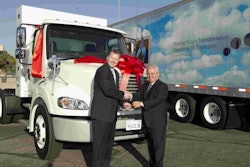Covenant Transportation Group Inc. on Wednesday, Nov. 9, announced financial and operating results for the 2011 third quarter ended Sept. 30:
• Total revenue was $161.4 million, a decrease of 2.1 percent compared with the third quarter of 2010;
• Freight revenue was $126.5 million, a decrease of 9.0 percent;
• Operating loss was $9.8 million and operating ratio was 107.7 percent, which includes pre-tax goodwill impairment charges of $11.5 million, compares with operating income of $8.2 million and an operating ratio of 94.1 percent; and
• Net loss was $11.2 million, which includes after-tax noncash goodwill impairment charges of $9.4 million, compared with net income of $1.9 million.
David Parker, chairman, president and chief executive officer of the Chattanooga, Tenn.-based company, said the noncash goodwill impairment charge does not affect Covenant’s liquidity, cash flows, day-to-day operations, competitive position or compliance with the financial covenants in the revolving credit facility, and that the charge wrote off the remaining goodwill associated with several acquisitions that were made prior to 2001.
“We are disappointed to recognize the impairment, but realize that it does not change anything about our fundamental business operations or our future earnings potential,” Parker said. “The remaining shortfall versus our financial results of the third quarter of 2010 is primarily attributable to a decrease in our average miles per tractor, or utilization.”
Parker attributed the decline in utilization to a decline in the freight market for its long-haul services, reduced efficiency of loading trucks and freight optimization related to the early July implementation of the company’s new enterprise management software at Covenant Transport, and reducing unprofitable business at the company’s Star Transportation regional truckload subsidiary, where it increased pricing to profitable levels on selected lanes.
“The simple fact is that we have not been getting enough freight revenue per tractor to justify serving all of our lanes,” Parker said. “We have been working with our customers on improving this over the last year, and will continue to evaluate decisions in coordination with our customers as to which freight is worth transporting. Then we need to agree on rates, lanes and freight levels that make sense for both of us.”











